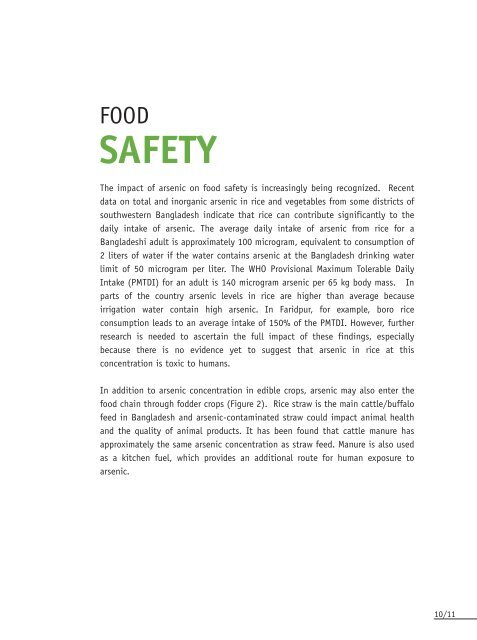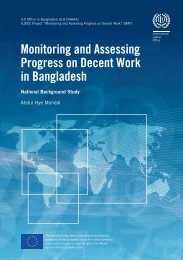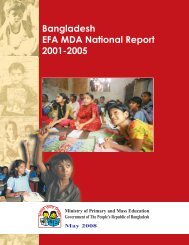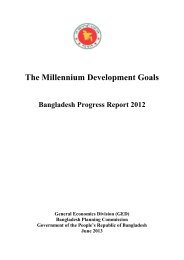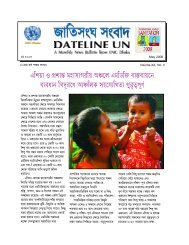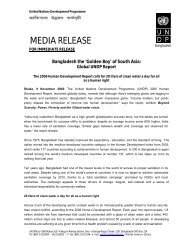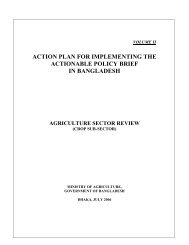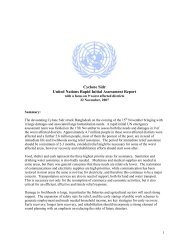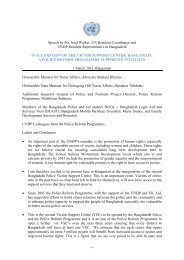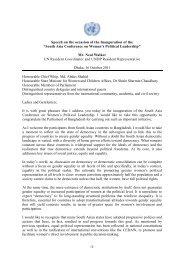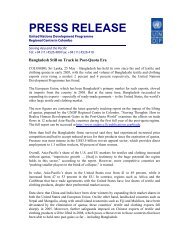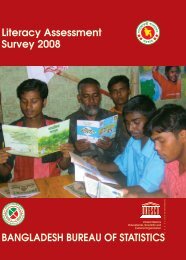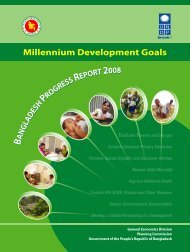Towards an Arsenic Safe Environment in Bangladesh - Unicef
Towards an Arsenic Safe Environment in Bangladesh - Unicef
Towards an Arsenic Safe Environment in Bangladesh - Unicef
- No tags were found...
Create successful ePaper yourself
Turn your PDF publications into a flip-book with our unique Google optimized e-Paper software.
FOODSAFETYThe impact of arsenic on food safety is <strong>in</strong>creas<strong>in</strong>gly be<strong>in</strong>g recognized. Recentdata on total <strong>an</strong>d <strong>in</strong>org<strong>an</strong>ic arsenic <strong>in</strong> rice <strong>an</strong>d vegetables from some districts ofsouthwestern B<strong>an</strong>gladesh <strong>in</strong>dicate that rice c<strong>an</strong> contribute signific<strong>an</strong>tly to thedaily <strong>in</strong>take of arsenic. The average daily <strong>in</strong>take of arsenic from rice for aB<strong>an</strong>gladeshi adult is approximately 100 microgram, equivalent to consumption of2 liters of water if the water conta<strong>in</strong>s arsenic at the B<strong>an</strong>gladesh dr<strong>in</strong>k<strong>in</strong>g waterlimit of 50 microgram per liter. The WHO Provisional Maximum Tolerable DailyIntake (PMTDI) for <strong>an</strong> adult is 140 microgram arsenic per 65 kg body mass. Inparts of the country arsenic levels <strong>in</strong> rice are higher th<strong>an</strong> average becauseirrigation water conta<strong>in</strong> high arsenic. In Faridpur, for example, boro riceconsumption leads to <strong>an</strong> average <strong>in</strong>take of 150% of the PMTDI. However, furtherresearch is needed to ascerta<strong>in</strong> the full impact of these f<strong>in</strong>d<strong>in</strong>gs, especiallybecause there is no evidence yet to suggest that arsenic <strong>in</strong> rice at thisconcentration is toxic to hum<strong>an</strong>s.In addition to arsenic concentration <strong>in</strong> edible crops, arsenic may also enter thefood cha<strong>in</strong> through fodder crops (Figure 2). Rice straw is the ma<strong>in</strong> cattle/buffalofeed <strong>in</strong> B<strong>an</strong>gladesh <strong>an</strong>d arsenic-contam<strong>in</strong>ated straw could impact <strong>an</strong>imal health<strong>an</strong>d the quality of <strong>an</strong>imal products. It has been found that cattle m<strong>an</strong>ure hasapproximately the same arsenic concentration as straw feed. M<strong>an</strong>ure is also usedas a kitchen fuel, which provides <strong>an</strong> additional route for hum<strong>an</strong> exposure toarsenic.10/11


